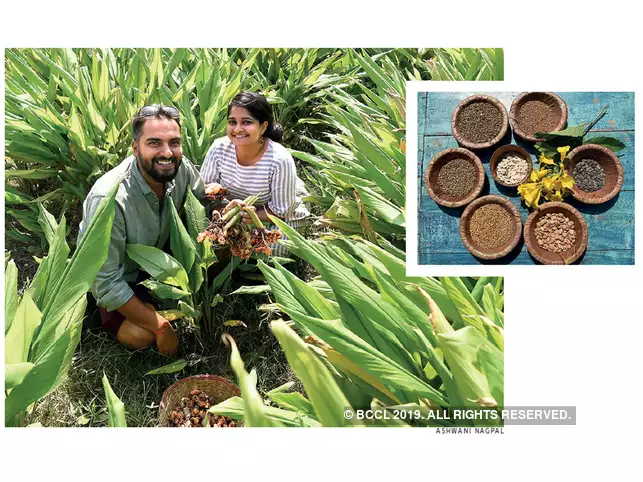Heirloom crops, indigenous varieties are making a comeback

Among the comforting certainties that make life navigable are things we take for granted — okra is green, corn is yellow and sweet potato has brown skin. What we seldom pause to ponder is that this wasn’t necessarily the case always. The colours we associate with vegetables and fruits just happen to be from strains that are most suited for large-scale cultivation, and became consequently dominant over a period of time.
A movement is now afoot among a small band of farmers, activists and plant breeders across India to bring back varieties that thrived in the past, lending a greater diversity and colour to our farms and plates. Their harvest includes red okra, black and blue corn, purple sweet potato, white- and purple-striped groundnut and other varieties. While consumers are finding these healthier and exotic, farmers are finding them more remunerative and pest-resistant. Restaurants love adding them to the menu because of the novelty factor.
“The list of unknown or lesser known desi or heirloom crops is endless. All these varieties were widely grown and eaten till just a hundred years ago, but disappeared as seed companies started commercialising hybrids and genetically modified variants. Reviving them is part of the movement of going back to our roots,” says Bengaluru-based seed keeper Prabhakar Rao.
He has currently 560 varieties of heirloom seeds that he’s marketing through his brand Hariyalee Seeds. He has a range of vegetables such as Bangladeshi brinjal, which was popularly used in biryani in undivided Bengal, red corn, red sausage tomato, purple okra and silver queen okra.
“If you go back a century, globally there were 544 varieties of cabbage, 480 varieties of peas, 408 varieties of tomato, 341 varieties of pumpkin and 307 varieties of sweet corn. Bringing back these crop varieties is critical to preserving bio-diversity,” says Rao, who has studied the field deeply.
In Noida in the National Capital Region (NCR), Neha Bhatia and Puneet Tyagi of The Prodigal Farms grow heirloom crops such as gongura spinach, purple hyacinth beans and rare purple sweet potato.
In Chennai, Ananthoo, an activist with Safe Food Alliance, runs the notfor-profit organic retail outlet Restore, which has helped revive awareness and markets for minor millets such as kodo (varagu), foxtail (thinai), little millet (saamai) and proso (pani varagu).
Bharat Beej Swaraj Manch, a nationwide network for conserving and regenerating seed diversity and self-reliance, has been promoting traditional varieties of rice, pulses, tubers, vegetables and a variety of millets, and creating new markets for them.
It isn’t easy for seed keepers to promote forgotten heirloom varieties. For one, awareness is low. While these varieties flourished when people mostly ate seasonal produce, with changing eating habits and lack of availability of these varieties they have disappeared from dining tables. One method that seed keepers have found to be effective is to share recipes and health benefits of these crops with consumers.
“We have forgotten how to cook some of these veggies. So the best thing is to send recipe cards with the produce,” says Tyagi. He adds that there is a growing demand for indigenous produce from consumers and hoteliers alike, which has helped drive sales. From their 20-acre farms in Noida, Bhimtal and Muzaffarnagar, they cater to around 100 families in the NCR region with heirloom crops forming around 50% of the vegetable basket. There is definitely scope for more, as the availability of quality heirloom seeds gets better, says Tyagi.
Apart from selling to consumers, they also supply vegetables to various cafes across NCR, the latest being Together At 12th at Le Meridien Gurgaon, owned by chef Vanshika Bhatia, a strong advocate of local, seasonal and indigenous produce.
Heirloom crops are currently a novelty and farmers are getting premium price. “A bowl of multicolour cherry tomatoes — red, yellow, green and black — is being sold for Rs 300 by a farmer,” says Rao, adding that five-star hotels and farm-to-table specialty restaurants are asking for white capsicum as well as cinnamon basil, also known as Mexican spice basil.
Many of these crops, it is also claimed, can prevent lifestyle diseases. “The brown top millet, known as ghas ki roti in Bundelkhand, contains almost 17% dietary fibre, compared with 11% in oats,” says Ananthoo. “This variety of millet was almost lost and consumed only by a few tribals. It took Sahaja Samrudha, which promotes organic farming, and Bharat Beej Swaraj Manch (BBSM) some time to revive it in Karnataka and get it back on the market,” he says.
This movement resists the homogenization of our diets and the rejection of the seasonal and the local. It tries to replace polished white grains and refined flour with fibre-rich food.
In Noida and surrounding areas, farmers had stopped growing the indigenous purple sweet potato and opted for hybrid varieties that are bigger and heavier and have a greater yield, says Prodigal Farms’ Tyagi. The scene is changing now with the purple variety proving to be far more cost-effective and pestresistant, better in taste and even useful as a garnish due to its vibrant purple colour, he adds.
The brown-skinned sweet potato now retails for Rs 90 a kg, while consumers pay Rs 120 for a kilo of the purple-skinned sweet potato. A premium of Rs 30 per kilo compensates for the lower yield. There is the added advantage of lower input costs. This ensures that farmers get higher returns.
The scale might still be small, but the efforts to revive heirloom crops are off to a promising start.
Source : economictimes.indiatimes.com